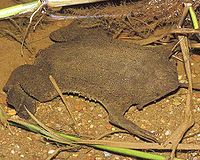Surinam toad
| Surinam toad | |
|---|---|

| |
| Scientific classification | |
| Kingdom Information | |
| Kingdom | Animalia |
| Subkingdom | Bilateria |
| Phylum Information | |
| Phylum | Chordata |
| Sub-phylum | Vertebrata |
| Infraphylum | Gnathostomata |
| Class Information | |
| Superclass | Tetrapoda |
| Class | Amphibia |
| Sub-class | Lissamphibia |
| Order Information | |
| Order | Anura |
| Sub-order | Archeobatrachia |
| Family Information | |
| Superfamily | Pipoidea |
| Family | Pipidae |
| Sub-family | Pipinae |
| Genus Information | |
| Genus | Pipa |
| Species Information | |
| Species | P. pipa |
| Population statistics | |
| Population | unknown |
The Surinam toad is a small frog of the genus Pipa, and found in tropical ponds and still waters of the Amazon Basin of South America. It's unusual characteristic - the laying of eggs and the hatching of young entirely within the skin of the female's back - has presented a severe problem for the theory of evolution.
Description
Surinam toads have a flattened, leaf-shaped body 6 to 8 inches long. They are brown to dark-brown on top, and lightly-colored underneath; a "T"-shaped mark, similar to an autopsy cut, is prominent on its belly. The head is triangular, bearing tiny black eyes at either end. Females have a "spongy" back skin.
Distribution and habitat
Surinam toads live in waters which are oxygen-poor, murky, muddy, or polluted; the waters also have some leaf debris from trees, allowing the toads to camouflage themselves on the bottom while waiting for their prey, which is small fish or underwater insects. Although living their entire lives in the water, they must come to the surface to breathe.
The toads are found in Peru, Brazil, Venezuela, and the Guianas, inhabiting the entire drainage area of the Amazon river.
Breeding
Breeding takes place when there is a drop in water temperature and levels rise. Males attract females by making clicking sounds underwater; once there the male grasps the female and both swim about in somersaulting motions.
While in the males grasp, the female lays her eggs on the male's belly with a long oviduct, which is then fertilized. The male then places the eggs on the female's back, where they adhere to her dorsal skin; the skin swells around the eggs within 24 hours, and fully-encloses them within 10 days. The young develop in this manner until they hatch within 12 to 20 weeks, emerging from her skin as fully-formed toads[1].
Evolutionary problem
According to evolution, Surinam toads first appeared some 90 million years ago as Pachybatrachus taqueti, in what is now the Republic of Niger[2], and scientists state that fossil remains have been found in Africa and South America.
Charles Darwin stated "If it could be demonstrated that any complex organ existed which could not possibly have been formed by numerous, successive, slight modifications, my theory would absolutely break down"[3]. The explanation given by evolution for the toad's method of breeding is the drying up of ponds and streams; this necessitated the development of the long oviduct and spongy back over a period of eons. The problem with that explanation is when water dries up, the Surinam toad would need such body modifications and the ability to use them immediately or the species would become extinct; a back skin modified to collect and preserve eggs is entirely useless without the male's ability to place them there.[4]
References
- ↑ http://www.youtube.com/watch?v=aCayq56wHSA
- ↑ http://www.answers.com/topic/pipidae-1
- ↑ Charles Darwin. The Origin of Species, New York: New American Library, 1958 p. 171
- ↑ http://www.welovegod.org/ministry_files/The_Reading_Room/Evolution_n_Creation_2/Toads_Disagree_with_Darwin.shtml